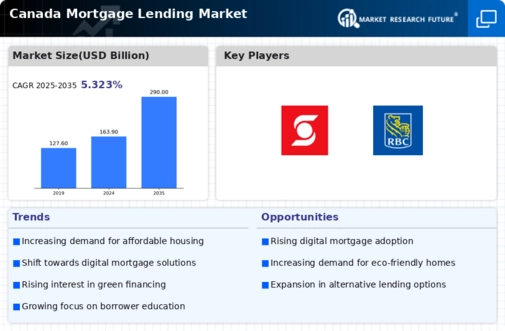Rising Housing Prices
the mortgage lending market in Canada is influenced by the persistent rise in housing prices. As of November 2025, the average home price in major cities has surged, with some areas experiencing increases of over 10% annually. This trend compels potential homebuyers to seek larger loans, thereby driving demand within the mortgage lending market. The heightened competition among lenders to offer attractive mortgage products further intensifies this dynamic. Additionally, the increasing cost of homeownership may lead to a greater reliance on mortgage financing, as buyers look to secure their investments in a volatile market. Consequently, lenders are adapting their offerings to accommodate the evolving needs of consumers, which may include longer amortization periods and innovative financing solutions.
Interest Rate Fluctuations
Interest rates play a pivotal role in shaping the mortgage lending market in Canada. As of November 2025, the Bank of Canada has maintained a cautious approach to interest rate adjustments, with rates hovering around 3.5%. This stability appears to encourage borrowing, as consumers are more likely to secure favorable mortgage terms. However, any potential shifts in monetary policy could lead to increased rates, which might dampen demand for new mortgages. Lenders are thus closely monitoring economic indicators to anticipate changes that could impact their pricing strategies. The interplay between interest rates and consumer confidence is crucial, as higher rates could deter first-time buyers, while lower rates may stimulate activity in the mortgage lending market.
Demographic Shifts and Urbanization
Demographic changes are significantly impacting the mortgage lending market in Canada. The ongoing trend of urbanization, with younger generations gravitating towards metropolitan areas, is driving demand for housing. As of November 2025, millennials represent a substantial portion of homebuyers, often seeking flexible mortgage options that align with their lifestyle preferences. This demographic shift necessitates that lenders adapt their products to cater to the unique needs of younger consumers, who may prioritize features such as portability and prepayment options. Additionally, the increasing diversity within urban populations may lead to a broader range of financial products being offered, as lenders strive to meet the varied needs of different cultural groups within the mortgage lending market.
Technological Advancements in Lending
the mortgage lending market in Canada is undergoing a transformation driven by technological advancements. Innovations such as online mortgage applications and automated underwriting processes are streamlining the lending experience for consumers. As of November 2025, approximately 60% of mortgage applications are submitted online, reflecting a significant shift towards digital solutions. This trend not only enhances efficiency but also allows lenders to reach a broader audience. Furthermore, the integration of artificial intelligence in risk assessment is enabling lenders to make more informed decisions, potentially reducing default rates. As technology continues to evolve, it is likely that the mortgage lending market will see further enhancements in customer service and operational efficiency.
Government Incentives and Support Programs
Government initiatives play a crucial role in shaping the mortgage lending market in Canada. As of November 2025, various programs aimed at first-time homebuyers, such as the First-Time Home Buyer Incentive, are designed to make homeownership more accessible. These incentives can lower the financial barriers for potential buyers, thereby stimulating demand within the mortgage lending market. Furthermore, regulatory frameworks that promote responsible lending practices are essential in maintaining market stability. The government's focus on affordable housing solutions may also lead to increased collaboration between public and private sectors, fostering innovation in mortgage products. As these initiatives evolve, they are likely to have a lasting impact on the landscape of the mortgage lending market.













Leave a Comment